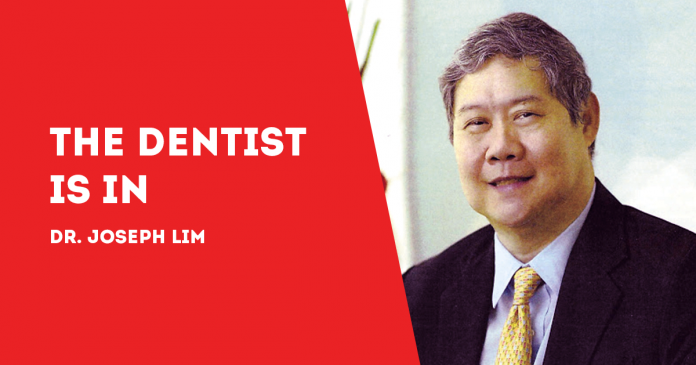
DENTISTS are more at risk of exposure to SARS-CoV-2, the virus that causes COVID-19.
The US Centers for Disease Control and Prevention guidelines for infection control in the dental setting have cited the potential usefulness of pre-procedural mouthwashes in reducing the spread of airborne infection of all types.
“Many questions need to be addressed in relation to whether oral hygiene could represent a viable approach to dampen transmission of SARS-CoV-2, and research is required to address this,” observes a new research suggesting that mouthwash is an effective tool in slowing down or preventing the spread of COVID-19.
The study, published June 5 in Function, a journal of the American Physiological Society, was led by Professor Valerie B. O’Donnell of the Systems Immunity Research Institute, School of Medicine, University Hospital of Wales in Cardiff; and Professor David Thomas in the School of Dentistry of the same university hospital.
As in the column previous to this, we emphasize that the study only suggests the possible effectiveness of the mouthwash. We do not encourage its use to prevent COVID-19.
As in all medications, a dentist’s or a doctor’s advice is always highly recommended. Otherwise, do not – repeat do not – self-medicate.
The study is worth mentioning as a piece of information and not – again, not – as a medical advice.
There are many varieties of mouthwashes.
There is chlorhexidine widely used for oral health in the United Kingdom. According to the study, it is effective against Gram-positive bacteria, but to a lesser extent Gram-negative bacteria and fungi.
Chlorhexidine is often formulated with ethanol at lower concentrations, which may in part explain its virucidal impact.
A recent review of coronavirus literature identified that chlorhexidine exposure for 10 minutes only weakly inactivated coronavirus strains in suspension tests although the concentration used was low at 0.02 percent.
Chlorhexidine formulations have been shown to retain oral antimicrobial activity for up to 12 hours.
“Despite lower activity toward coronaviruses, a combination of chlorhexidine with alcohol may offer a useful strategy for reducing viral load over longer times,” observe Professors O’Donnell and Thomas.
Chlorhexidine mouthwashes have been a critical clinical tool for over 40 years to reduce oral bacteria and prevent infection and mucositis in cancer patients receiving chemotherapy and radiotherapy.
However, say Professors O’Donnell and Thomas, there are no reported studies assessing the impact of mouthwashes in specifically preventing or treating viral infections in neutropenic patients, or patients with a low level of neutrophils, a type of white blood cell.
A recent meta-analysis showed that chlorhexidine (rinse or gel) can reduce risk of ventilator-associated pneumonia in patients undergoing mechanical ventilation, although causative organisms were not described, the researchers say.
They also mention Povidone-Iodine (PVP-I), a mouthwash widely studied in relation to broad-spectrum antimicrobial and virucidal actions.
In laboratory settings in Japan, it rapidly inactivates SARS-CoV, MERS-CoV, influenza virus A (H1N1) and rotavirus.
A second study, also in Japan, showed that PVP-I (0.23 percent) is equivalent to 70 percent ethanol in inactivating SARS-CoV in laboratory settings. Indeed, based on limited clinical studies, Japan’s Ministry of Health, Labor and Welfare supported daily gargling as a protective measure to prevent upper respiratory tract infections.
A small number of human studies supporting this in the case of PVP-I have shown reduced incidence of both bacterial and viral (influenza) infection through repeated gargling, Professors O’Donnell and Thomas say.
In one rather limited study, the absence rate in middle schools in Yamagata City was compared over three months, where PVP-I gargling was encouraged in one school, versus seven schools where it was not.
The study found a reduction of school absence due to colds and influenza. In another study, a group of 23 patients gargled more than four times a day. Acute exacerbation of chronic respiratory infection was reduced by around 50 percent.
The importance of higher concentrations of PVP-I as a broad-spectrum antimicrobial agent for topical uses is indicated by its inclusion on the World Health Organization’s List of Essential Medicines.
It should be noted that rare allergic reactions have been reported for PVP-I, according to the University Hospital of Wales in Cardiff study.
***
Dr. Joseph D. Lim is the former Associate Dean of the UE College of Dentistry, former Dean of the College of Dentistry, National University, past president and honorary fellow of the Asian Oral Implant Academy, and honorary fellow of the Japan College of Oral Implantologists. Honorary Life Member of Thai Association of Dental Implantology. For questions on dental health, e-mail or text 0917-8591515./PN

